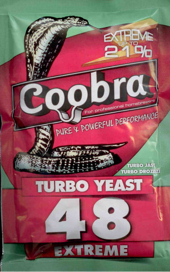Fermentacja w praktyce
Drożdże przeprowadzają proces fermentacji, jednak zapewne nie wiesz o nim wszystkiego. Fermentacja alkoholowa jest bowiem w istocie procesem, który tylko z pozoru jest prosty. Jeśli zamierzasz samodzielnie  produkować jakikolwiek alkohol, dobrze by było, gdybyś na temat fermentacji wiedział jak najwięcej, żebyś mógł świadomie wpływać na jej przebieg.
produkować jakikolwiek alkohol, dobrze by było, gdybyś na temat fermentacji wiedział jak najwięcej, żebyś mógł świadomie wpływać na jej przebieg.
Podstawa podstaw
Fermentacja alkoholowa, czyli reakcja enzymatycznego rozkładu glukozy, opisywana jest tak zwanym równaniem Gray-Lucasa. Wynika z niego tyle, że proces ten powoduje wydzielenie sporej ilości energii (w tym sporej ilości w postaci ciepła), a także wytworzenie alkoholu etanolowego oraz dwutlenku węgla. Gdyby przeanalizować stechiometrię równania reakcji, okazałoby się, że z każdych 100 g cukru drożdże mogą wyprodukować nieco ponad 51 g alkoholu. Pamiętaj jednak, że jest to tylko teoria.
Praktyczne równanie fermentacji
Wytworzenie alkoholu jest dla drożdży jedynie ubocznym (zresztą często niepożądanym) efektem fermentacji. Podstawowym celem jej przeprowadzania jest uwolnienie energii wiązań chemicznych glukozy. Ile z tego wynika dla winiarza czy piwowara? Tyle że w praktyce nie cały cukier zostanie zamieniony w alkohol. Straty będą spowodowane różnymi procesami metabolicznymi, a także zmiennością rozpuszczalności alkoholu w otoczeniu zawierających sporo dwutlenku węgla. Doświadczalnie wyznaczono, że około jednej dziesiątej cukru nie jest przetwarzane na alkohol, co pozwala na określenie ilości cukru, z którego powstaje jeden litr alkoholu, na 1,7 kilograma.
Problem chemii organicznej
Jeśli masz podstawowe pojęcie o chemii organicznej, to być może wiesz, że związki o identycznym wzorze sumarycznym mogą wyglądać różnie. To powoduje, że w wyniku najróżniejszych procesów chemicznych można przekształcić glukozę w inne związki, niekoniecznie pożądane, choć stechiometria równania nadal będzie zgodna. Tak zresztą przebiegają wszystkie procesy biologiczne: równania pozostają jedynie na papierze, a natura działa inaczej. Dlatego też w czasie fermentacji mogą powstawać różne związki, których obecność w mieszaninie nadaje jej przykry smak. Mieszaninę tych niepożądanych substancji nazywa się olejem fuzlowym, a w jej skład wchodzą między innymi: alkohol amylowy, propylowy i izobutylowy, a także estry, ketony i aldehydy. W roztworze znajdą się także różne inne substancje, które są uwalniane do środowiska w przypadku perforacji lub autolizy komórek drożdży.
Aby zapobiegać powstawaniu oleju fuzlowego, należy przede wszystkim obniżyć temperaturę fermentacji dla drożdży. Zalecane jest utrzymanie jej na poziomie około 20 stopni. W zasadzie drożdże mogą znieść temperaturę nawet dwukrotnie wyższą, ale nie licząc powstawania oleju fuzlowego, nie należy dopuszczać do wzrostu temperatury z jednego jeszcze powodu: im wyższa będzie, tym szybciej drożdże będą obumierały. Spore stężenie alkoholu tylko przyspiesza ten proces, ponieważ uwrażliwia drożdże na wzrost temperatury.
Tlen? Najlepiej nie
Fermentacja jest sposobem oddychania beztlenowego, ergo, jak sama nazwa wskazuje, zasadniczo należy odciąć dopływ tlenu do kadzi fermentacyjnej. Oczywiście niewielkie jego ilości nie są groźne, natomiast zbyt duża zawartość tlenu może niekorzystnie oddziaływać na drożdże. Specjalnie ukształtowane baniaki oraz elementy dodatkowe powodują, że do kadzi fermentacyjnej dostaje się jak najmniej tlenu, który dodatkowo w ciepłej mieszaninie kiepsko się rozpuszcza, więc przy dnie panują warunki ściśle beztlenowe. To gwarancja dobrego smaku oraz prawidłowo przebiegającej fermentacji, dlatego o uszczelnieniu wszystkich połączeń należy pomyśleć odpowiednio wcześniej.








